Exploring the Aerodynamic Effect of Blade Gap Size via a Transient Simulation of a Four-Stage Turbine
Abstract
:1. Introduction
2. Research Methodology
2.1. Low-Pressure Turbine Configurations
2.2. Numerical Setup and Boundary Conditions
2.3. Turbulence Model Validation
2.4. Mesh Sensitivity Validation
3. Results and Discussion
3.1. Aerodynamic Characteristics
3.2. Transport Structure of the Wake in the Flow Field
3.3. Midspan Flow Field Characteristics
3.4. Secondary Flow
4. Conclusions
- 1.
- A large blade gap contributes to an increase in efficiency under all variable expansion ratio conditions. The increase in isentropic efficiency when the gap is expanded is attributed to the reduction in the profile losses in the main stream area. When the S3–R3 gap is expanded, the increase in losses in the hub area does not outweigh the reduction in losses in the main stream area, resulting in the highest isentropic efficiency in the case of AG-0.8.
- 2.
- The wake entering the R3 row is reduced significantly when the axial gap is expanded. The reduction in TKE just upstream of the R3 leading edge in AG-0.8 is about 25% compared to that of AG-0.2, which indicates that the intensity of the wake shows obvious decay when mixed with the main stream while being transported downstream.
- 3.
- A wake with a stronger intensity leads to a periodic velocity fluctuation of a larger amplitude on the suction surface. Similarly, the unsteady effect of the upstream wake has a larger impact on the load of the R3 blade in the case of AG-0.2, resulting in higher loads at certain instants. Overall, wakes with higher intensity have the greatest impacts on the front part of the R3 blade. The load on the front of the blade is reduced. Meanwhile, the “negative jet” effect caused by a strong wake leads to a reduction in the R3 incidence angle when the S3–R3 gap is reduced.
- 4.
- The high-loss regions caused by the passage vortex are periodically reduced by the incoming wakes. In particular, wakes with higher intensity have better effects on passage vortex suppression.
Author Contributions
Funding
Institutional Review Board Statement
Informed Consent Statement
Data Availability Statement
Conflicts of Interest
Nomenclature
| Cax | Axial chord, m | |
| (r, θ, z) | Cylindrical coordinate system | |
| y+ | Y plus | |
| Y | Total pressure loss coefficient | |
| η | Efficiency | |
| v | Average mesh volume, m3 | |
| l | Average mesh size, m | |
| Cp | Pressure coefficient | |
| Subscripts | ||
| lower 0 | Fluid domain outlet | |
| lower 1 | Fluid domain inlet | |
| Abbreviations | ||
| LPT | Low-pressure turbine | |
| RANS | Reynolds-averaged Navier–Stokes | |
| URANS | Unsteady Reynolds-averaged Navier–Stokes | |
| AG | Axial gap | |
| TLV | Leakage vortex | |
| PV | Passage vortex | |
| TKE | Turbulence kinetic energy | |
References
- Curtis, E.; Hodson, H.; Banieghbal, M.; Denton, J.; Howell, R.; Harvey, N. Development of blade profiles for low-pressure turbine applications. J. Turbomach. 1997, 119, 531–538. [Google Scholar] [CrossRef]
- Howell, R.J.; Hodson, H.P.; Schulte, V.; Stieger, R.D.; Schiffer, H.P.; Haselbach, F.; Harvey, N.W. Boundary layer development in the BR710 and BR715 LP turbines: The implementation of high lift and ultra high lift concepts. J. Turbomach. 1997, 124, 385–392. [Google Scholar] [CrossRef]
- Mayle, R.E. The 1991 IGTI scholar lecture: The role of laminar-turbulent transition in gas turbine engines. J. Turbomach. 1991, 113, 509–536. [Google Scholar] [CrossRef]
- Meyer, R.X. The Effects of Wakes on the Transient Pressure and Velocity Distributions in Turbomachines. Trans. Am. Soc. Mech. Eng. 1958, 80, 1544–1551. [Google Scholar] [CrossRef]
- Hodson, H.P.; Dawes, W.N. On the Interpretation of Measured Profile Losses in Unsteady Wake-Turbine Blade Interaction Studies. J. Turbomach. 1998, 120, 276–284. [Google Scholar] [CrossRef]
- Mahallati, A. Aerodynamics of a Low-Pressure Turbine Airfoil Under Steady and Periodically Unsteady Conditions. In Proceedings of the ASME Turbo Expo, Vienna, Austria, 6–17 June 2004. [Google Scholar]
- Smith, L.H. Wake Dispersion in Turbomachines. J. Fluids Eng. 1966, 88, 688–690. [Google Scholar] [CrossRef]
- Stieger, R.D.; Hodson, P. The Unsteady Development of a Turbulent Wake Through a Downstream Low-Pressure Turbine Blade Passage. J. Turbomach. 2005, 127, 388–394. [Google Scholar] [CrossRef]
- Schulte, V.; Hodson, H.P. Unsteady wake-induced boundary layer transition in high lift LP turbines. J. Turbomach. 1988, 120, 28–35. [Google Scholar] [CrossRef]
- Liang, Y.; Zou, Z.P.; Liu, H.X.; Zhang, W.H. Experimental investigation on the effects of wake passing frequency on boundary layer transition in high-lift low-pressure turbines. Exp. Fluids 2015, 56, 81. [Google Scholar] [CrossRef]
- Michelassi, V.; Chen, L.W.; Pichler, R.; Sandberg, R.D. Compressible direct numerical simulation of low-pressure turbines-part II: Effect of inflow disturbances. J. Turbomach. 2015, 137, 071005. [Google Scholar] [CrossRef]
- Schneider, C.M.; Schrack, D.; Kuerner, M.; Rose, M.G.; Staudacher, S.; Guendogdu, Y.; Freygang, U. On the Unsteady Formation of Secondary Flow Inside a Rotating Turbine Blade Passage. J. Turbomach. 2014, 136, 061004. [Google Scholar] [CrossRef]
- Qu, X.; Zhang, Y.; LU, X.; Zhu, J. Unsteady experimental and numerical investigation ofaerodynamic performance in ultra-high-lift LPT. Chin. J. Aeronaut. 2020, 33, 1421–1432. [Google Scholar] [CrossRef]
- Pichler, R.; Michelassi, V.; Sandberg, R.; Ong, J. Highly Resolved Large Eddy Simulation Study of Gap Size Effect on Low-Pressure Turbine Stage. J. Turbomach. 2018, 140, 21003. [Google Scholar] [CrossRef]
- Biester, M.H.; Wiegmann, F.; Guendogdu, Y.; Seume, J.R. Time-Resolved Numerical Study of Axial Gap Effects on Labyrinth-Seal Leakage and Secondary Flow in a LP Turbine. In Proceedings of the Turbo Expo: Power for Land, Sea, and Air, San Antonio, TX, USA, 3–7 June 2013; ASME: New York, NY, USA, 2013; Volume 55225. [Google Scholar] [CrossRef]
- ANSYS Inc. ANSYS CFX 14.0 Solver Theory Guide; ANSYS Inc.: Canonsburg, CA, USA, 2011. [Google Scholar]
- Jameson, A. Time dependent calculations using multigrid, with applications to unsteady flows past airfoils and wings. In Proceedings of the 10th Computational Fluid Dynamics Conference, Honolulu, HI, USA, 24–26 June 1991. [Google Scholar] [CrossRef]
- Arnone, A.; Pacciani, R. Rotor-Stator Interaction Analysis Using the Navier–Stokes Equations and a Multigrid Method. J. Turbomach. 1996, 118, 679–689. [Google Scholar] [CrossRef]
- Yu, J.; Wang, Y.; Song, Y.; Chen, F. Effect of the Honeycomb Tip with Injection on the Aerodynamic Performance in a 1.5-Stage Turbine. J. Turbomach. 2021, 143, 031002. [Google Scholar] [CrossRef]
- Cherry, D.G.; Gay, C.H.; Lenahan, D.T. Energy Efficient Engine Low Pressure Turbine Test Hardware Detailed Design Report; No. NAS 1.26:167956; NASA Technical Reports Server: Cleveland, OH, USA, 1982. [Google Scholar]
- Cherry, D.; Dengler, R. The aerodynamic design and performance of the NASA/GE e3 low pressure turbine. In Proceedings of the 20th Joint Propulsion Conference, Cincinnati, OH, USA, 11–13 June 1984. [Google Scholar]
- Wilcox, D.C. Multiscale model for turbulent flows. AIAA J. 1998, 26, 1311–1320. [Google Scholar] [CrossRef]
- Launder, B.E.; Spalding, D.B. Lectures in Mathematical Models of Turbulence; Academic Press: London, UK, 1972. [Google Scholar]
- Menter, F.R. Two-equation eddy-viscosity turbulence models for engineering applications. AIAA J. 1994, 32, 1598–1605. [Google Scholar] [CrossRef]
- Yakhot, V.; Thangam, S.; Gatski, T.B.; Orszag, S.A.; Speziale, C.G. Development of turbulence models for shear flows by a double expansion technique. Phys. Fluids A Fluid Dyn. 1992, 4, 1510–1520. [Google Scholar] [CrossRef]
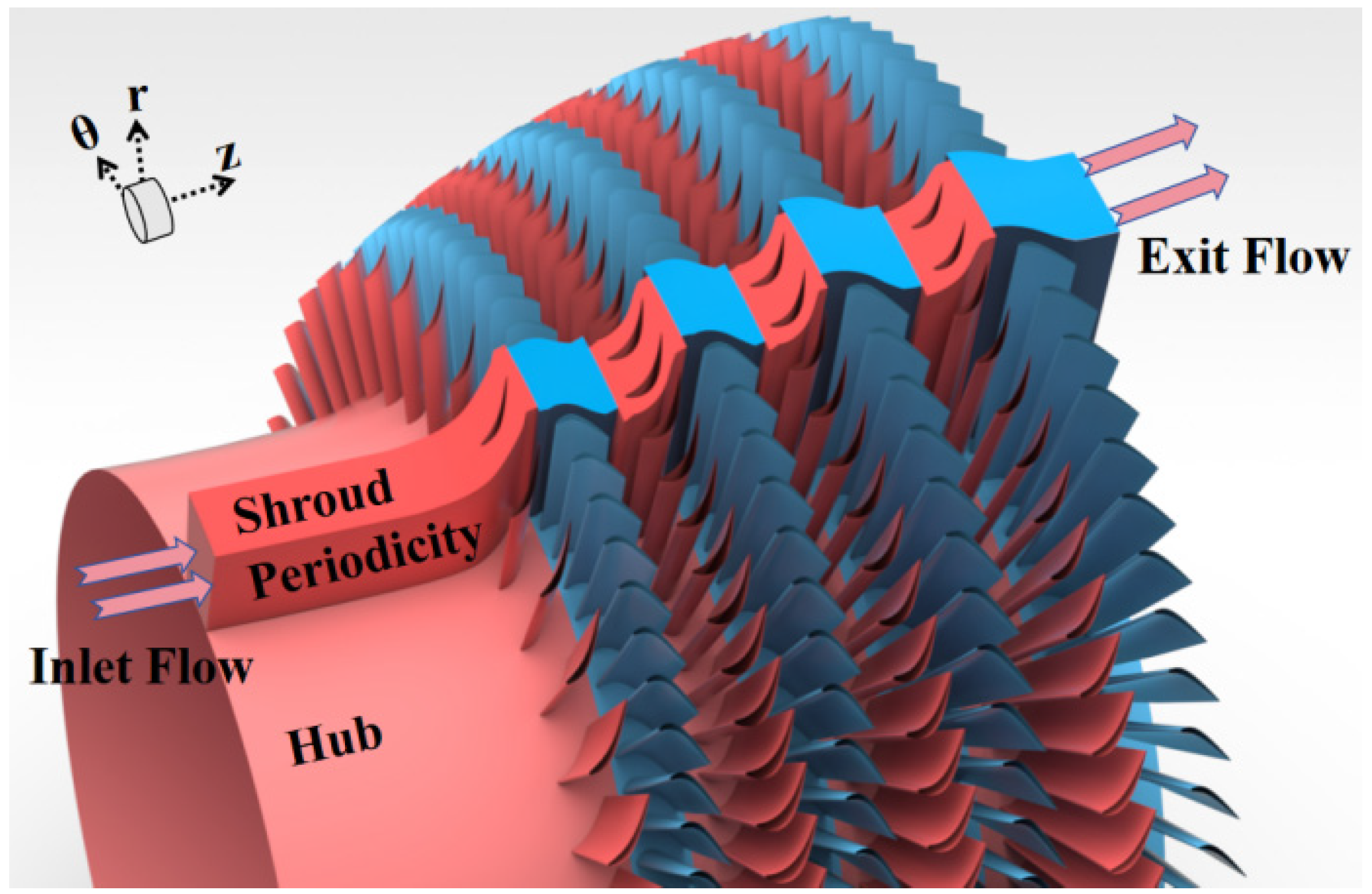



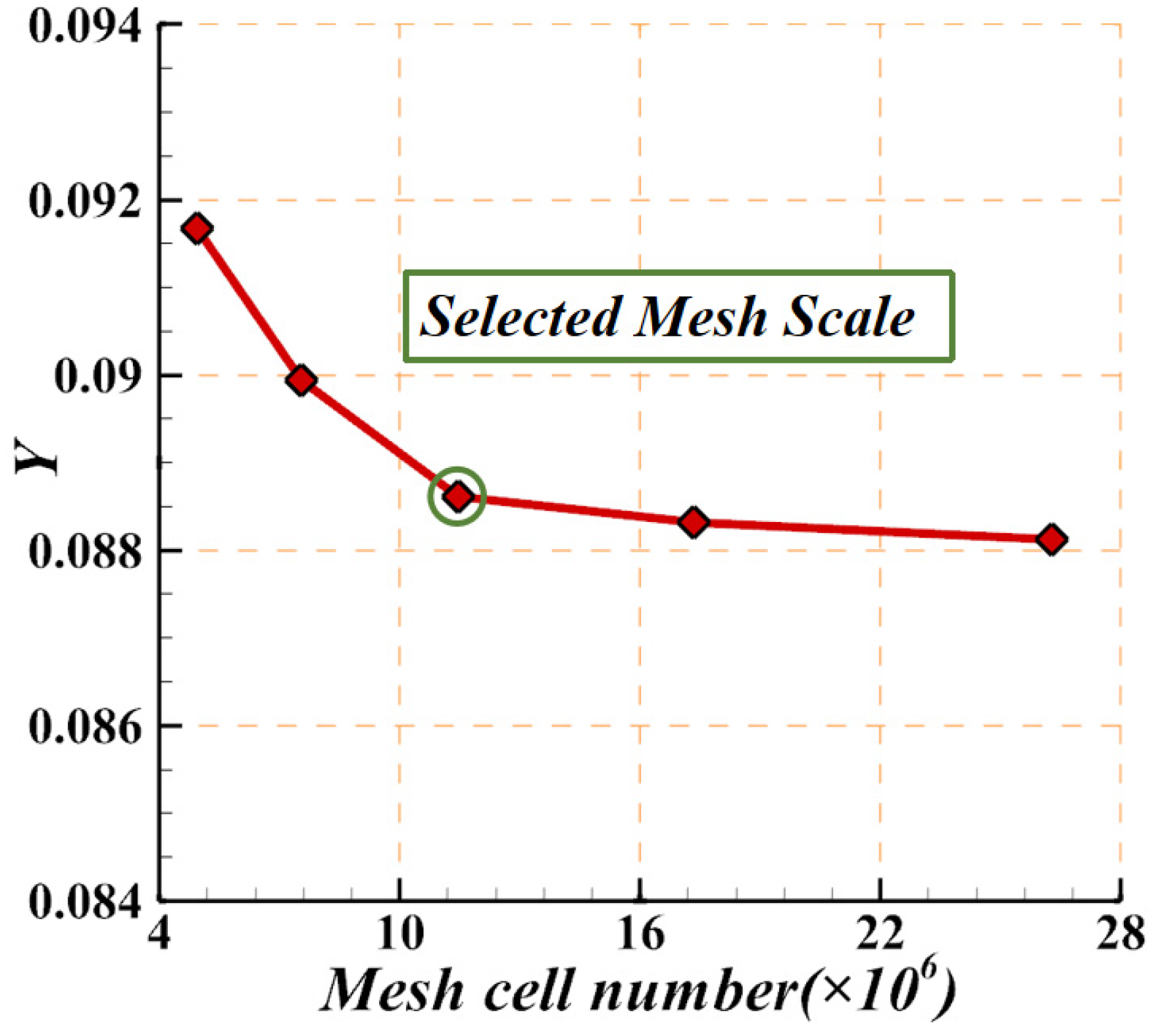

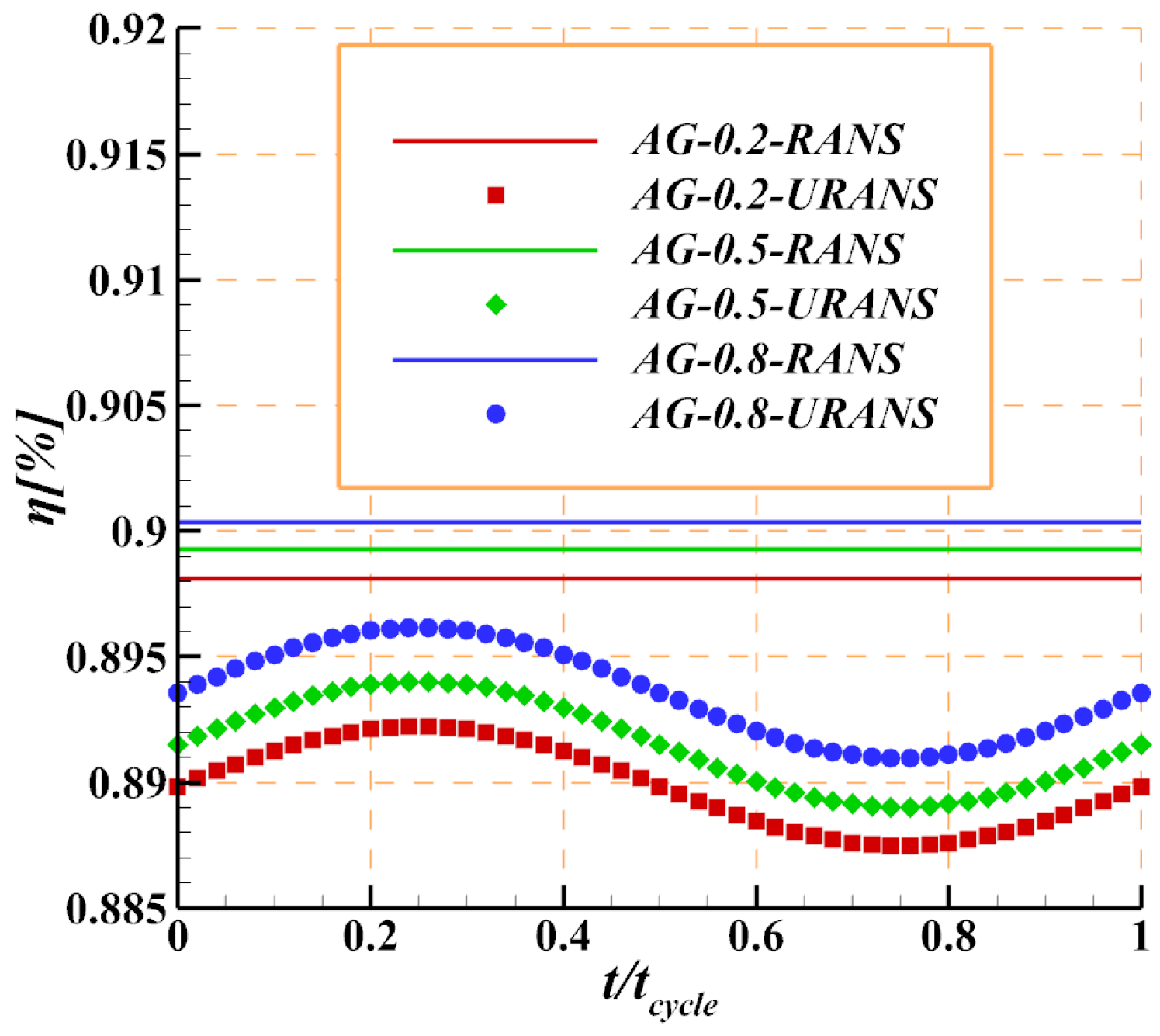
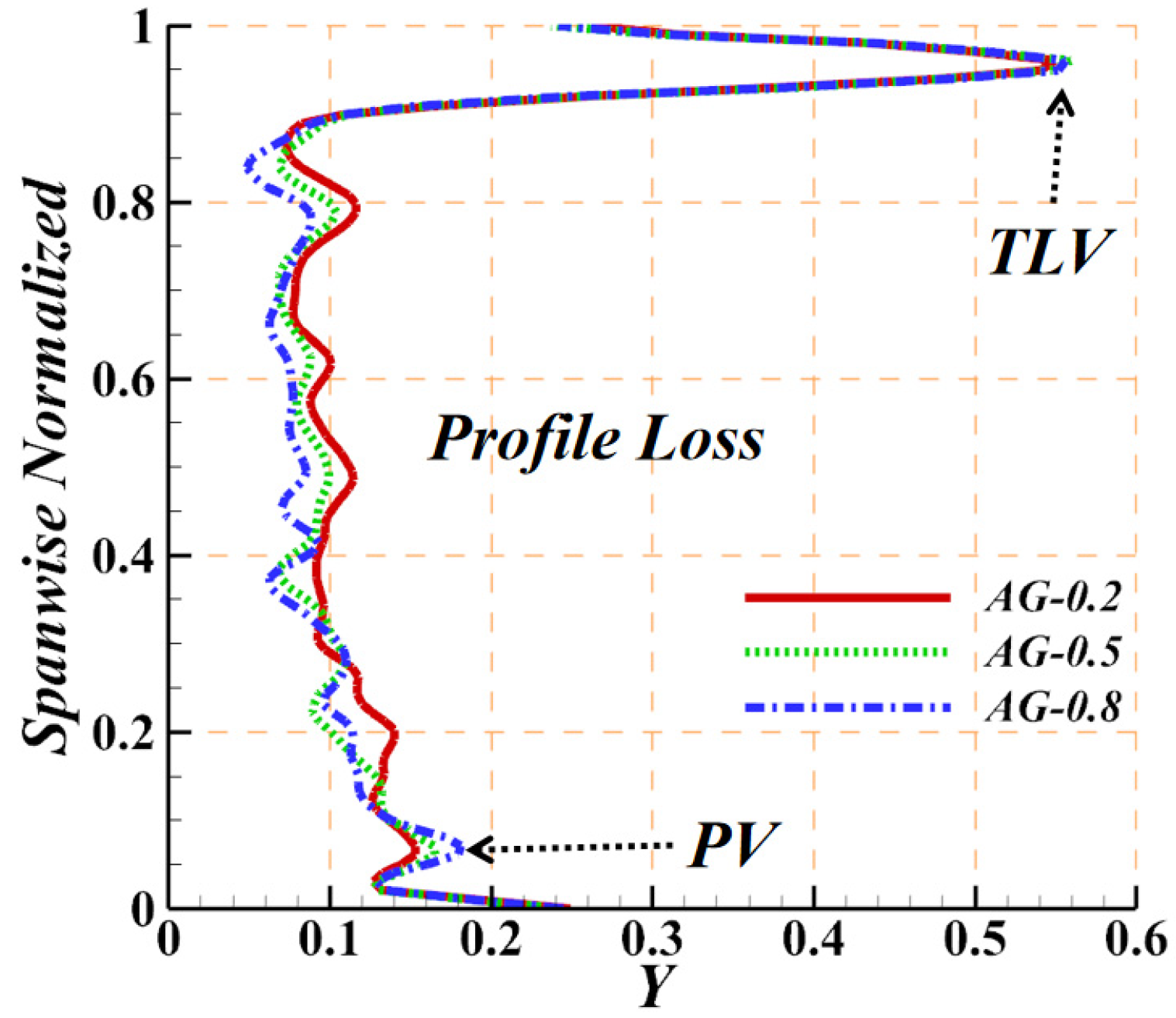
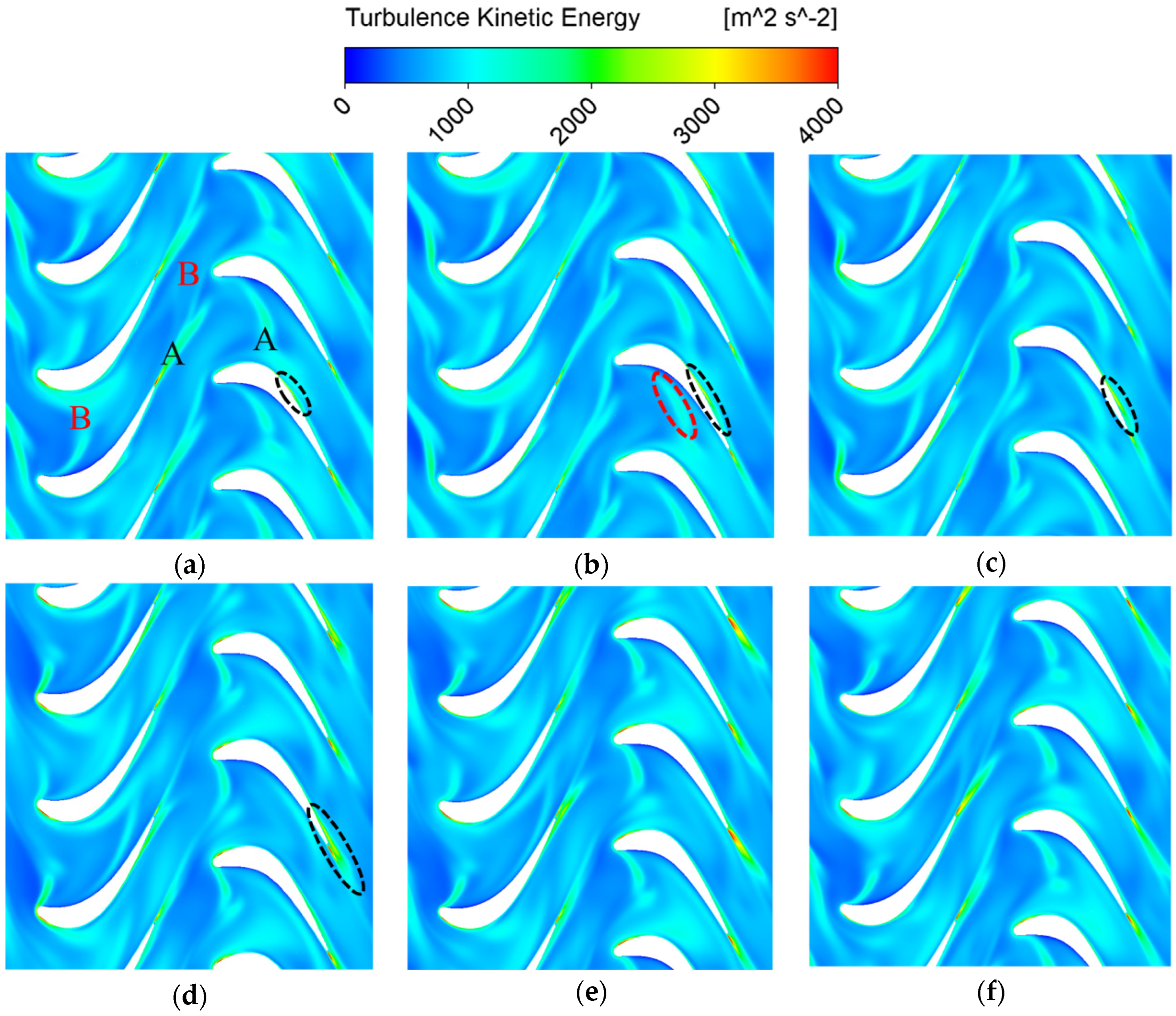
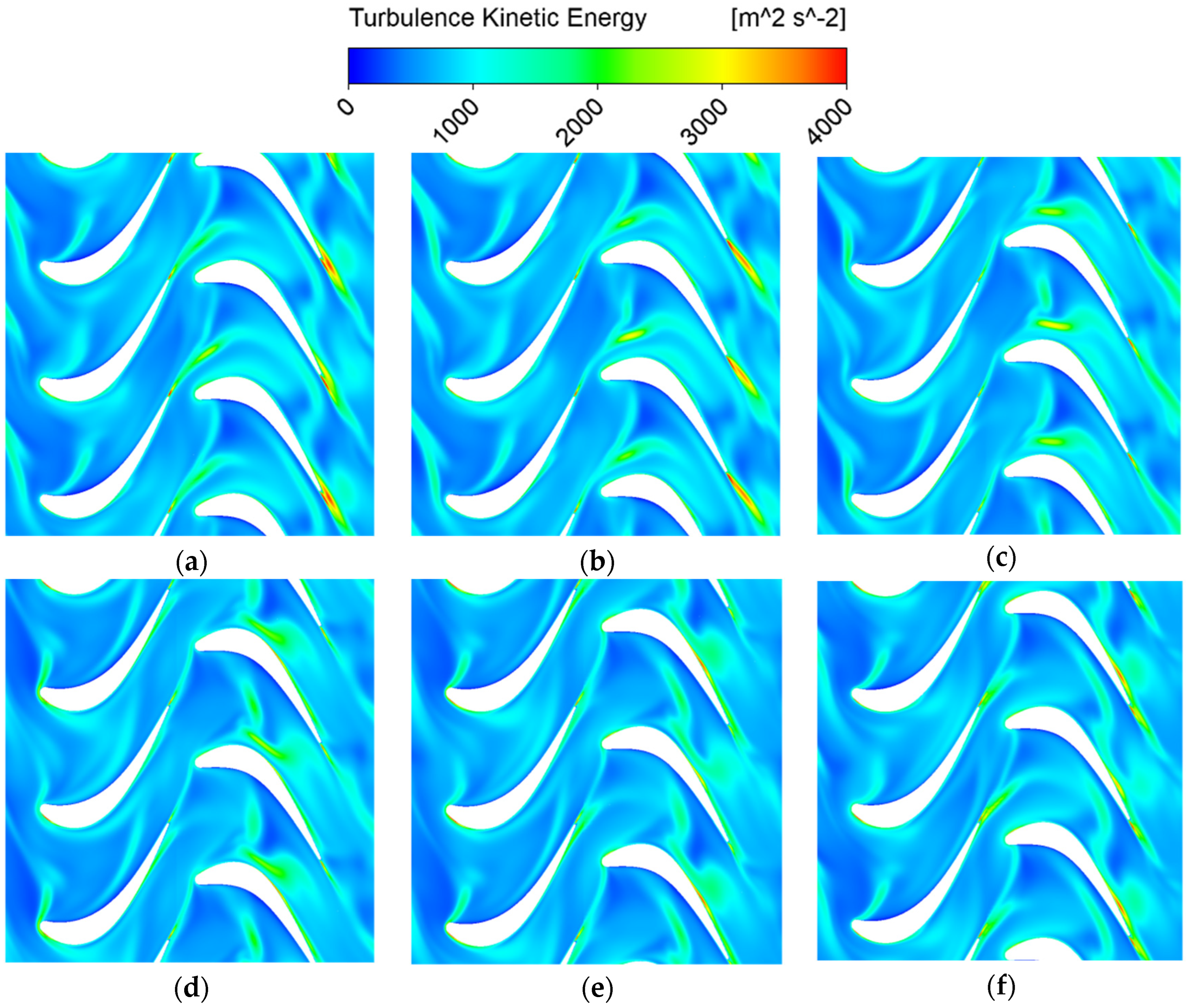
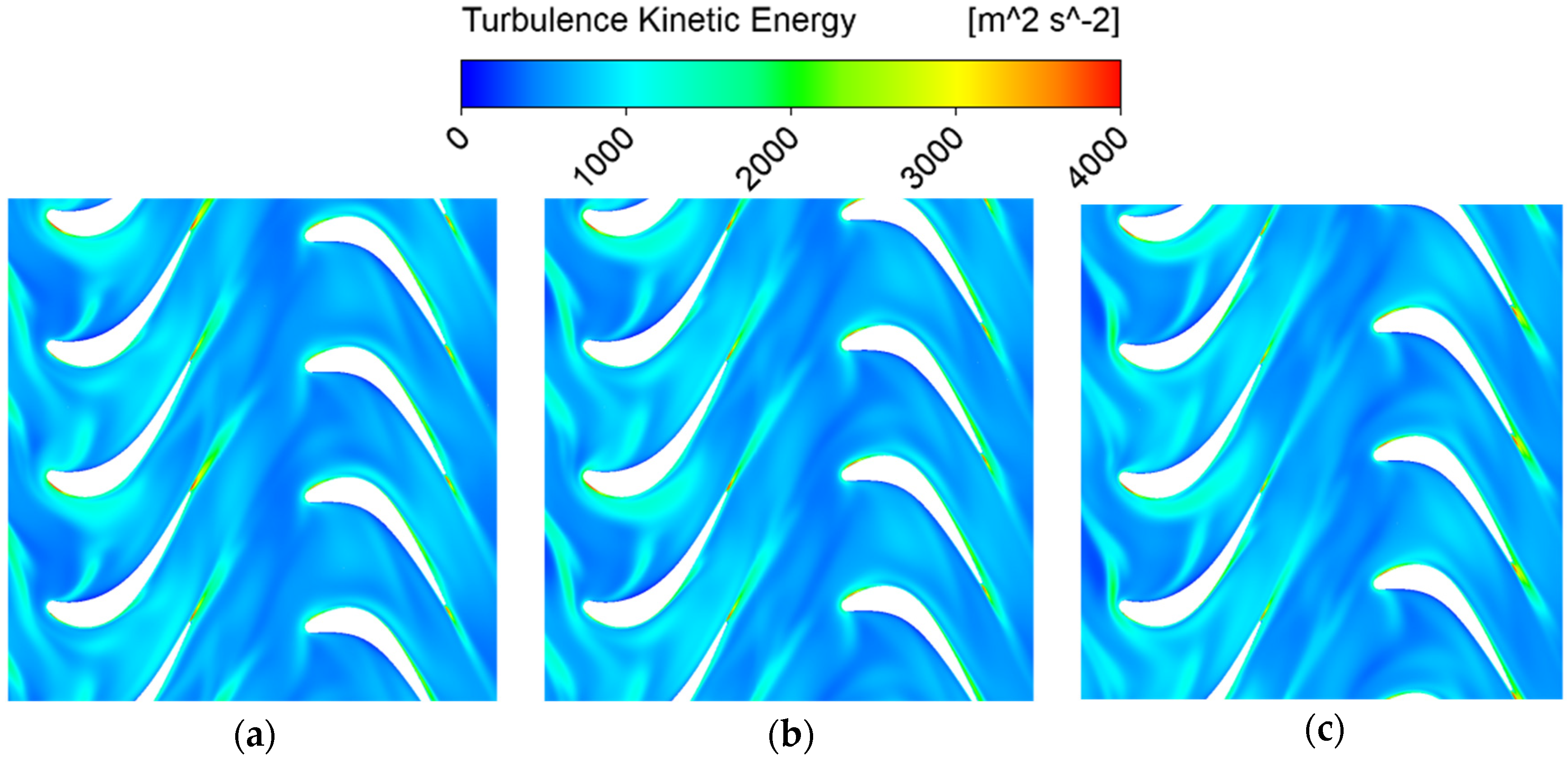

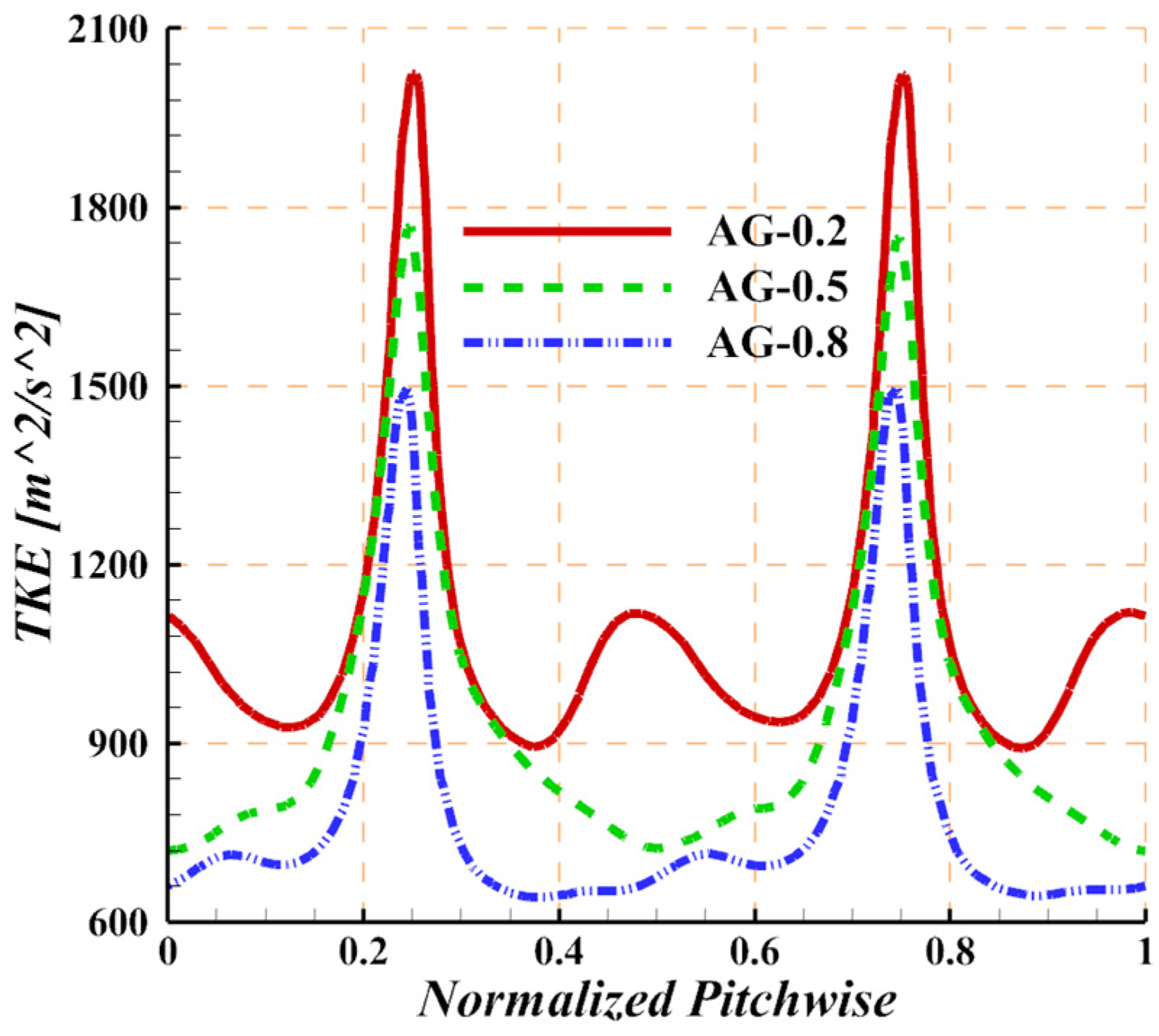



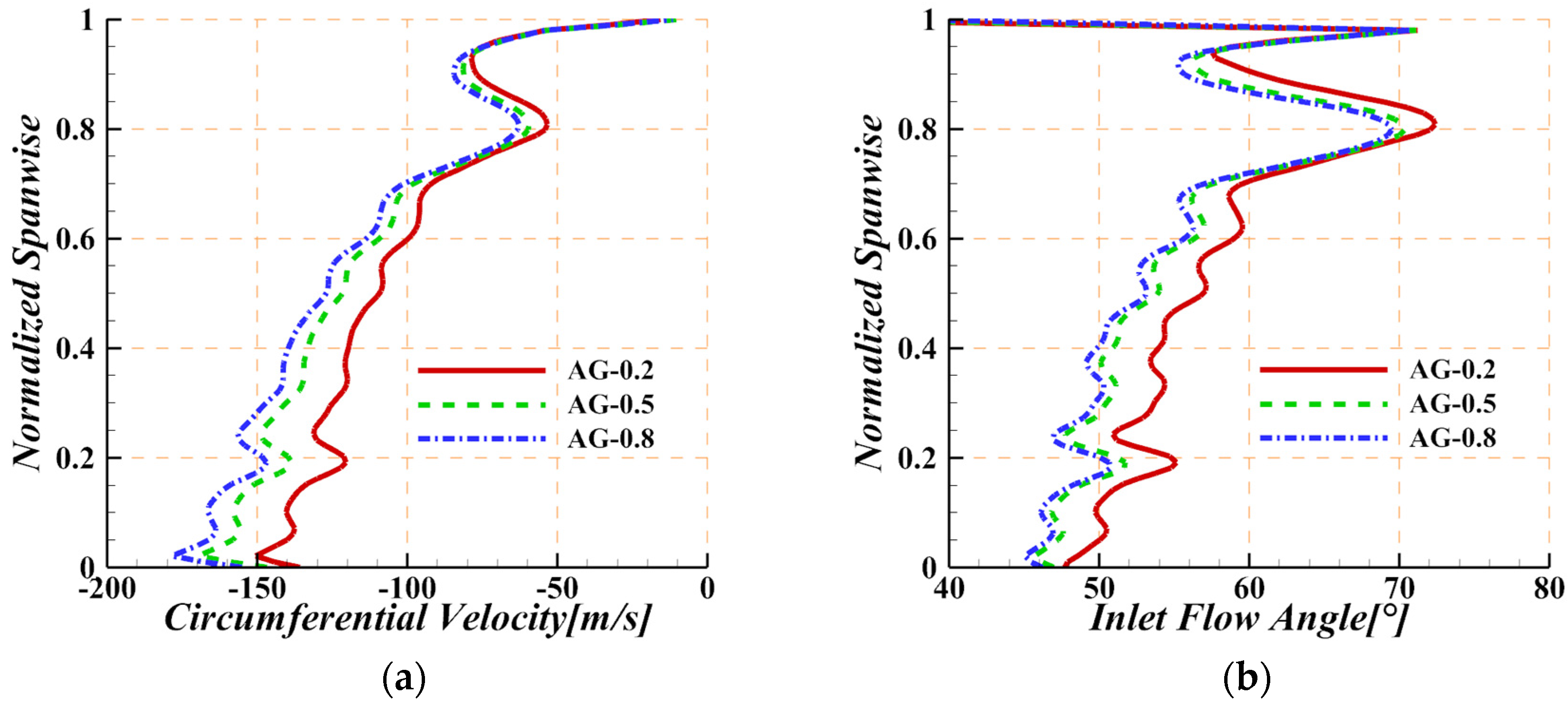
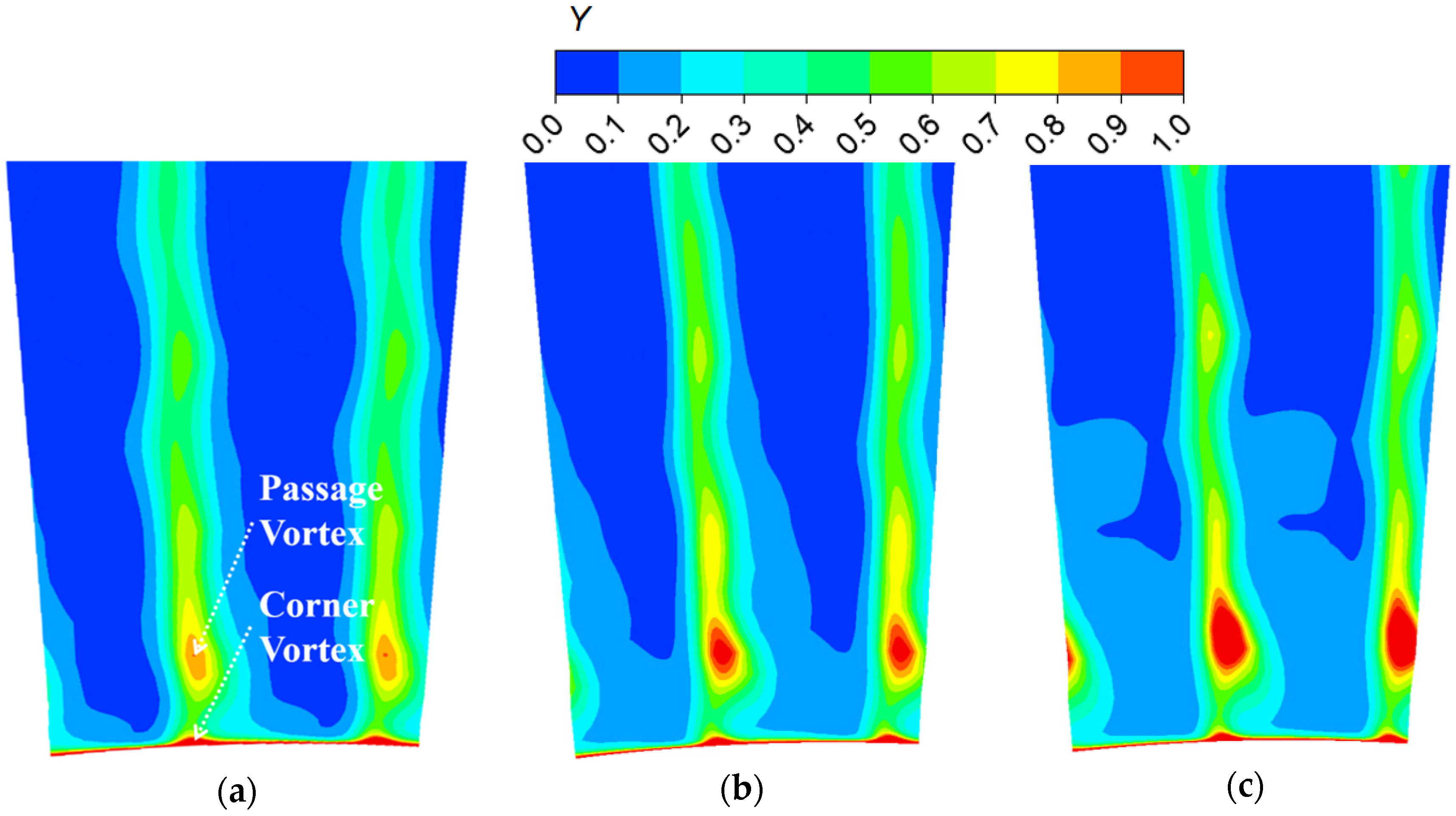

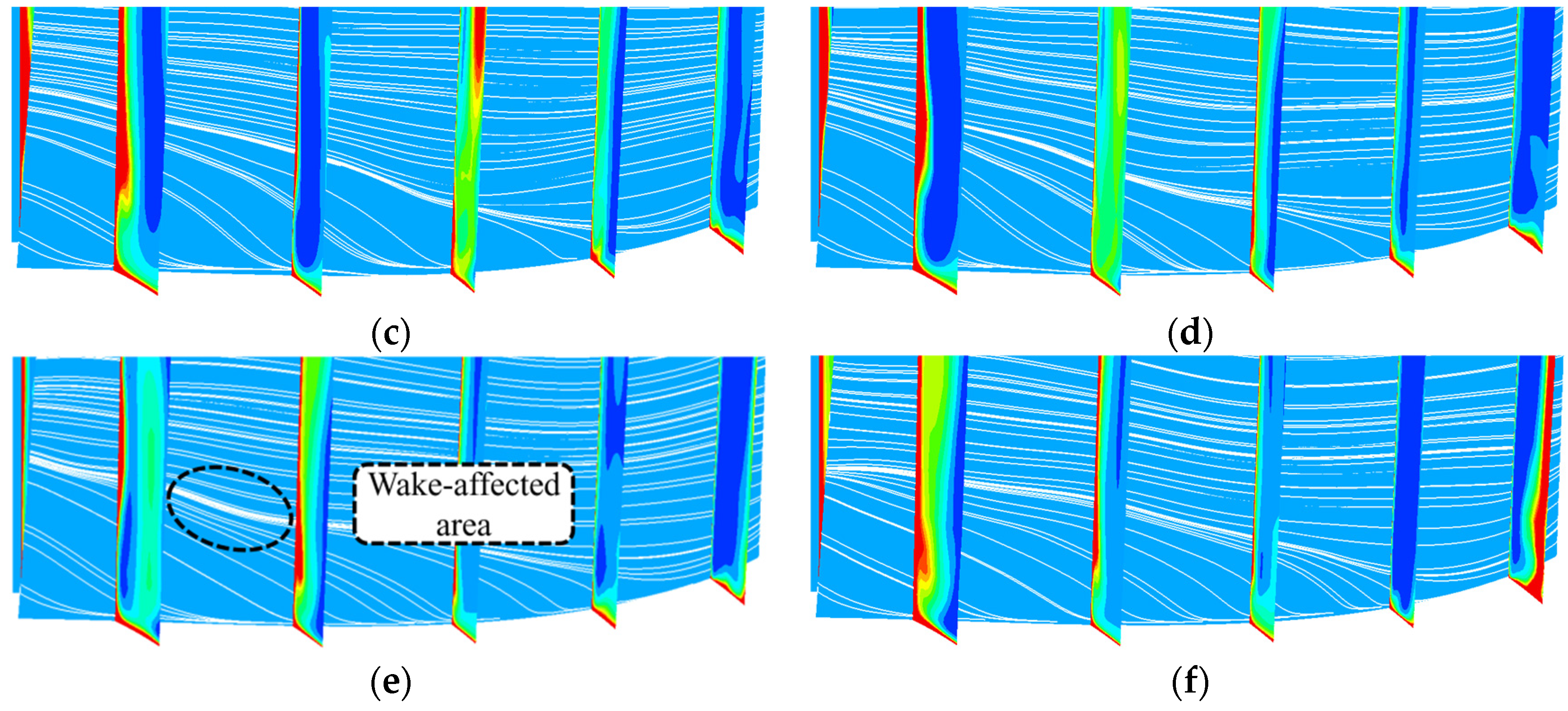


| Blade Row | Blade Numbers |
|---|---|
| S1 | 40 |
| R1 | 80 |
| S2 | 80 |
| R2 | 80 |
| S3 | 80 |
| R3 | 80 |
| S4 | 80 |
| R4 | 80 |
| Parameters | Values |
|---|---|
| Rotation speed (RPM) | 6210 |
| Rotation speed (RPS) | 103.5 |
| Stator blade numbers | 80 |
| Number of stationary blade passages passed by the rotor blades per second | 80 × 103.5 = 8280 |
| Time required for the rotor blades to traverse a stationary blade passage (s) | 1/8280 ≈ 1.21 × 10−4 |
| Selected time step (s) | 1 × 10−6 |
| Angle of rotor rotation for the blade passages passed by the rotor blades per second (°) | 360/80 = 4.5 |
| Angle of rotor rotation within a single time step (°) | 1 × 10−6 × 8280 × 4.5 = 0.03726 |
| Parameters | Values |
|---|---|
| Inlet total temperature (K) | 1098.3 |
| Inlet total pressure (kPa) | 217.9 |
| Turbulence intensity (%) | 5 |
| S1 incidence angle (°) | 10 |
| Outlet static pressure (kPa) | 37.9 |
| Parameters | Values |
|---|---|
| Inlet total temperature (K) | 416.7 |
| Inlet total pressure (bar) | 3.1 |
| Rotation speed (RPM) | 3208.7 |
| Inlet mass (kg/s) | 24.4 |
| PT1/PT2 | 4.37 |
| PT1/PS2 | 4.76 |
| Case | 1 | 2 | 3 | 4 | 5 |
|---|---|---|---|---|---|
| Cell numbers | 4,952,960 | 7,553,792 | 11,462,528 | 17,347,840 | 26,278,656 |
| Average mesh volume (v/m3) | 5.24 × 10−11 | 7.93 × 10−11 | 1.20 × 10−10 | 1.82 × 10−10 | 2.78 × 10−10 |
| Average mesh size (L/m) | 0.65 × 10−3 | 0.57 × 10−3 | 0.49 × 10−3 | 0.43 × 10−3 | 0.37 × 10−3 |
| Mean orthogonal quality | 0.897 | 0.906 | 0.909 | 0.911 | 0.913 |
| Mean determinant | 0.959 | 0.962 | 0.968 | 0.972 | 0.975 |
| Min determinant | 0.376 | 0.325 | 0.345 | 0.332 | 0.359 |
| Mean quality | 0.931 | 0.933 | 0.934 | 0.932 | 0.930 |
Disclaimer/Publisher’s Note: The statements, opinions and data contained in all publications are solely those of the individual author(s) and contributor(s) and not of MDPI and/or the editor(s). MDPI and/or the editor(s) disclaim responsibility for any injury to people or property resulting from any ideas, methods, instructions or products referred to in the content. |
© 2024 by the authors. Licensee MDPI, Basel, Switzerland. This article is an open access article distributed under the terms and conditions of the Creative Commons Attribution (CC BY) license (https://creativecommons.org/licenses/by/4.0/).
Share and Cite
Hu, X.; Cai, L.; Chen, Y.; Li, X.; Wang, S.; Fang, X.; Fang, K. Exploring the Aerodynamic Effect of Blade Gap Size via a Transient Simulation of a Four-Stage Turbine. Aerospace 2024, 11, 449. https://doi.org/10.3390/aerospace11060449
Hu X, Cai L, Chen Y, Li X, Wang S, Fang X, Fang K. Exploring the Aerodynamic Effect of Blade Gap Size via a Transient Simulation of a Four-Stage Turbine. Aerospace. 2024; 11(6):449. https://doi.org/10.3390/aerospace11060449
Chicago/Turabian StyleHu, Xinlei, Le Cai, Yingjie Chen, Xuejian Li, Songtao Wang, Xinglong Fang, and Kanxian Fang. 2024. "Exploring the Aerodynamic Effect of Blade Gap Size via a Transient Simulation of a Four-Stage Turbine" Aerospace 11, no. 6: 449. https://doi.org/10.3390/aerospace11060449
APA StyleHu, X., Cai, L., Chen, Y., Li, X., Wang, S., Fang, X., & Fang, K. (2024). Exploring the Aerodynamic Effect of Blade Gap Size via a Transient Simulation of a Four-Stage Turbine. Aerospace, 11(6), 449. https://doi.org/10.3390/aerospace11060449






